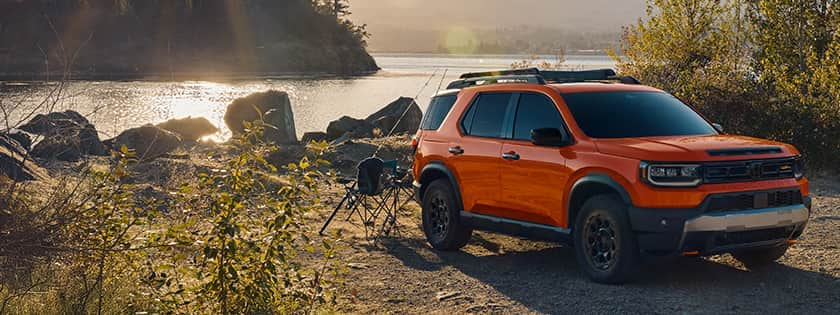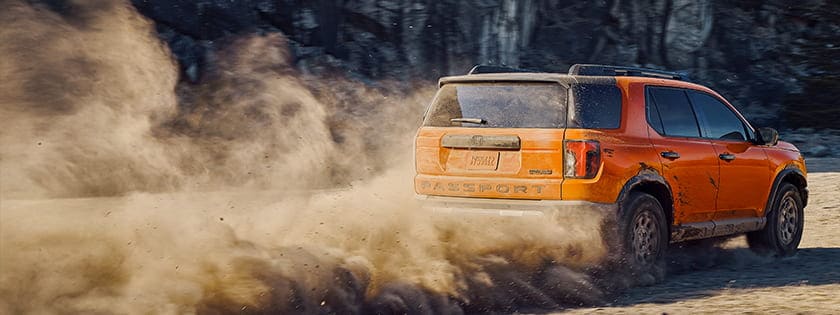"Turn it the wrong way and it'll let you know — you'll feel it right in your ass."
This is the astute counsel of Travis Howard, crew chief of the Madusa monster truck, moments before I wheel the supercharged, methanol-burning, 540-cubic-inch, Merlin V8-powered monster around a highly sterilized circuit designed to keep members of the media like me from killing myself (or others) while behind the wheel.
Howard means this in no uncertain terms. He is referring to the toggle switch that controls the truck's rear steering. And he's right. Move the switch the wrong way and your ass will likely be the first thing to tell you something is dramatically wrong as the truck crabs sideways, barely shifting its trajectory, instead of rotating in the desired direction.
Fearing I'd inevitably do it wrong and because I prefer that my keister never send messages my ego might later regret, I never touched the switch. Its operation, I admit, seemed intuitive. Push it right when turning the wheel right and the rear wheels steer out of phase with the fronts, allowing the truck to turn much more sharply than otherwise possible.
Turning sharply is an ability that a monster truck requires when negotiating the tight confines of a hockey arena, the sort of place where monster trucks often perform. But this is no hockey arena. This is the 2010 Monster Jam World Finals held at the massive Sam Boyd Stadium in Las Vegas. Monster Jam is the Grand Poobah of monster truck races. Speeds here exceed 70 mph, which gives you pause when you consider that the steering of a monster truck is accomplished by four hydraulic rams and the truck runs on 66-inch tires intended for 30 mph. As a result, the truck's steering is unfettered by anything I'd call "feel." All this is to say that the few men and women who wheel these "trucks" for a living genuinely earn their money.
But we're here less to drive than to understand what makes these machines tick and to dig up a few numbers. Specifically, we're here to test Grave Digger — the most popular monster truck on the planet.
Full Disclosure
Monster Jam is a production of Feld Entertainment, Inc., which also produces acts like Disney on Ice and the Ringling Brothers and Barnum & Bailey Circus. More important, it owns most of the trucks that compete in Monster Jam, and in fact 14 of the 24 trucks here are owned by Feld Entertainment. Because the company simultaneously orchestrates domestic and international truck shows and because Grave Digger is its main attraction, there are seven Grave Digger trucks currently in operation. We're concerned with no. 20, which is creator Dennis Anderson's current ride.
Anderson has been driving monster trucks for 28 years, so it's no surprise that he's the sport's most well-known name and most sought-after personality. He sold the rights to the Grave Digger name to Pace Motorsports in 1998. He also happens to have the heaviest right foot in the business and is utterly unafraid to use it.
Monster Jam competition is divided into two categories: racing and freestyle. The racetracks are between 300 and 1,000 feet long (depending on if you're using a hockey arena or an outdoor stadium) and include jumps — usually over crushed cars. First truck to the finish line wins. Freestyle is exactly as it sounds: two minutes of do-as-you-please destruction. The driver who produces the best combination of jumps, saves and broken parts usually wins. In an unlikely mix of figure skating, methanol and good-ol'-boy justice, scoring is subjective.
Our plan is to focus on racing, since that's where the meaningful numbers are generated. So we install our Racelogic VBOX III data logger deep into the Digger's heart, then sit back and watch the glory unfold.
Holy Crap
Here's a meaningful number for you: 1.52 seconds. That's the precise amount of time Grave Digger requires to achieve 30 mph from a standstill on its qualifying run for the World Finals. For comparison, the insanely quick 2010 Nissan GT-R needs 1.78 seconds and that's on pavement, while the Digger does it on dirt.
As the truck negotiates the track's first series of bends (so the driver is actually still unable to fully commit to the throttle), it blasts from 45-70 mph in 3.06 seconds, about the same amount of time required by a 2010 Chevy Camaro. The truck is certainly capable of a better number, but only if it's going straight.
And if these numbers aren't insane enough, here's another. If you drive the Digger this hard for a full mile, it'll consume about 140 gallons of fuel. Howard says that a single blast of just 300 feet will burn 8 gallons.
Inside the Black and Green Wrecking Machine
Digger, like all Feld trucks, is powered by a supercharged, all-aluminum 540-cubic-inch Merlin V8. Per the rules (yes, monster truck racing has rules), this engine utilizes the same 8-71 Roots-type blower as the other trucks and it's fueled by untainted methanol and hubris. Dustin Brown, crew chief for this particular Grave Digger, says the Digger's power plant makes 1,450 horsepower (or maybe 1,475), a statement that some of the Digger's competitors simply don't believe.
Still, in casual observation, it's hard to argue that this truck is vastly different from the others at the show. It utilizes the same nitrogen-charged shocks as most other trucks. It's required to use the same-size tires as the other trucks. And its tube-type chassis is built heavier than many because, well, it needs to last.
Its footprint is slightly larger than most other Feld-owned trucks thanks to wider axle housings and a marginally longer wheelbase. Only Tom Meents' Maximum Destruction truck, the Digger's main competition, is wider, longer and lighter.
Being the icon brand of monster truck racing has earned Anderson some privileges. Namely, it's that his current ride is built with the latest technology and the best parts available — a fact he readily acknowledges.
"You can build a $135,000 truck that's good for smaller shows or you can build a truck with billet spindles and billet pins and hard-core internal parts, none of which make a difference to the eye. That's a $230,000 truck." Grave Digger 20 is that truck.
The Dilemma
If there's one fundamental constant in monster truck competition, it's that every truck must run tires that are 66 inches tall and 43 inches wide. Ironically, it's these tires that pose the biggest challenge faced by the designers and drivers. Besides being disproportionately heavy, the tires act like giant springs at each corner, making the trucks behave like 5-ton pogo sticks.
Removing weight from the tires is a critical factor in making a truck competitive in racing. "Buffing" removes material by turning the tires on a machine that trims the height of the tread lugs to about half. Most tires are also shaved — a 12-14-hour investment per tire — to suit each driver's desired preferences for weight and grip. As a result, the stock tires are reduced in weight from 720 pounds each to a more manageable 640 pounds.
According to Ryan Anderson (Dennis Anderson's son), the monster truck teams lean toward one of two kinds of tires. You have your choice of Goodyear radials that cost about $2,500 each, or "China" tires manufactured in exotic Asia that (predictably) cost considerably less at $1,400 each but aren't as durable. Tire pressures range from 12-20 psi depending on whether the truck is running on dirt or concrete.
The key contributor to a monster truck's wildly erratic handling is the fact that 60 percent of its overall weight is unsprung. That is, the mass of the components that are unaffected by the control of springs and dampers (like the tires, axles and planetary assemblies, primarily) comes to about 60 percent of the truck's total weight. It's a suspension engineer's hell but a show promoter's heaven. When combined with massive horsepower, this unpredictable handling sells about 3.5 million tickets annually to Monster Jam events.
Putting It to the Ground
Here's another ridiculous fact: Accommodating the massive tires requires absurd torque multiplication. Drive reduction between the custom-built transfer case (which allows quick gear ratio changes) and the wheels is in the neighborhood of 21.8:1. Low axle ratios (in the neighborhood of 6:1) accomplish most of the job. The rest is up to the planetary gear assemblies at the end of each axle housing. Sourced from Clark military forklifts, they further reduce the drive by 3.52:1.
High-speed oversteer in a monster truck, so we're told, is about as easy to rein in as a night in Vegas with a sloshed Lindsay Lohan. So Anderson has to employ a little setup ploy to tame the wildly uncooperative physics at work in a 10,000-pound, 12-foot-tall monster truck traveling at 70 mph. The trick is to make the front axle ratio marginally taller than the rear (6.14:1 vs. 6.20:1). This effectively tries to stretch the truck out at speed, making it want to go straight. It's a strategy you'll not likely find in forms of motorsport where precision is more important.
Routine Maintenance
What monster trucks lack in precision, they make up in sheer utility. Because of a schedule that offers competition every weekend between the beginning of January and the middle of March in the U.S. and then the rest of the year in Asia, Europe or South America, all Feld trucks are kept on a rigorous maintenance program.
According to Howard, one man-hour of maintenance is required for every minute of competition. And that's if nothing breaks, which is like saying Donald Trump won't sound self-important if he keeps his mouth shut.
The reality is that this need for durability drives crew chiefs like Brown and Howard to change their trucks' motor oil and transmission fluid after every show. The result is that the engines typically produce 1,200-1,400 hp every event for two years before they're rebuilt or replaced.
According to Pablo Huffaker, chassis designer and regular Digger driver, none of the Feld trucks run limited-slip differentials because they simply don't last. Almost every truck utilizes a Detroit locker in the rear axle. Only a select few drivers opt for one up front.
And here's a little fact that might surprise you. Not long ago Huffaker tested carbon-ceramic brake rotors on a Feld truck. The performance was staggering — too powerful, really — but $2,500 per rotor didn't suit the budget.
Like a Go-Kart?
At the end of the day, it's making the truck survive a show that's the real measure of success in monster trucking. So it's somewhat ironic that I find myself at the wheel of the Madusa truck before it's to compete at the Monster Jam World Finals.
It's here, with some 1,000 hp underfoot (the truck was detuned before I drove) and lifeless steering at hand, that I come to fully appreciate what Anderson and the Grave Digger do every weekend.
Travis Howard's advice before I drive? "It's simple, like a go-kart — but you're way up in the air."
Right.
It's immediately obvious that success here isn't achieved with subtle inputs. Just starting the truck requires yanking two large T-handles that switch on the main power and fuel pump. Then it's a matter of cranking the starter with your thumb for a few seconds to build oil pressure and flipping on the ignition with your forefinger.
Do it right and the Merlin twists for a few seconds and then blasts to life with a bark that's as purposeful as it is deafening. It settles into the rhythmic, high-energy idle that can only come from a blown big block. Time stops. Heads turn two parking lots away. People notice.
Despite its Magnaflow mufflers, the Merlin's exhaust is expelled with sufficient energy to evacuate desert dust from the blacktop like a nitrous-oxide-injected leaf blower. Everything attached to the engine — from the truck's red, white and blue body panels to my spleen — shakes in perfect time with the mill's lopsided meter. It's an experience as wholly American as Kenny Loggins music on the Fourth of July.
Plant Your Foot
Once I get the OK, I drop Madusa in gear and creep forward. Opening the throttle any meaningful amount means shoving harder on the pedal than I'd prefer. Finally, all at once, the throttle snaps open and the truck jumps like a prodded cow. I time the next lunge at the pedal to correspond to the face of a small dirt ramp — an effort that results in all four tires leaving the ground for maybe a millisecond.
On the next pass I make peace with the lifeless steering and achieve probably 6 inches of air over the same ramp. Then, just as I'm calibrating my inputs to the titanic torque, heavy pedal efforts and Cadillac steering, the predictable happens: I'm shut down via the truck's remote ignition interrupter. Turns out, Howard's go-kart analogy is exactly right; just when the driving starts to be engaging, the administrators inevitably bring it to an anticlimactic halt.
It doesn't matter. Because it only takes a few seconds behind the wheel to confirm what I've always suspected: If I had a farm with acres of unmolested space, there's absolutely no vehicle on this planet that I'd rather have to molest them with than a monster truck. I'd guess Dennis Anderson agrees.
The manufacturer provided Edmunds this vehicle for the purposes of evaluation.




